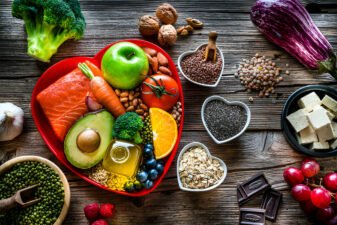The Glycemic Index was developed in 1981 to help people (especially diabetics and athletes) to maintain stable blood sugar levels.
- The glycemic index (GI) is a ranking of foods on a scale from 0 to 100 according to the extent to which they raise blood sugar levels after eating.
- Individual foods with a high glycemic index release glucose into the bloodstream quickly. This causes blood sugar levels to rise rapidly. Individual foods with a low glycemic index release glucose more steadily over several hours. This helps to keep blood sugar levels relatively calm.
- Pure glucose has a ranking of 100 on the glycemic index and all other foods are ranked in relation to glucose.
- Foods that rank as “high” on the index include ice cream, croissants, raisins and other dried fruit, bananas, carrots and watermelon. Foods that rank as ” moderate” on the glycemic index (45-60) include most types of pasta, baked beans, green peas, sweet potatoes, orange juice, blueberries and rice. “Low” glycemic index foods (under 45) include beans, cruciferous vegetables and high-fiber, low-sugar cereals, low-fat unsweetened plain yogurt, grapefruit, apples and tomatoes.
- It remains a very useful comparative indicator of how quickly foods are absorbed into the bloodstream.
For the latest information (2005), see GI Diet Method
Drawbacks of the Glycemic Index Ratings
GI Ratings are for Individual Foods – not Combinations of Foods
As pointed out by the American Diabetes Association (ADA), the differences in rates of digestion ranked by the Glycemic Index are not as great as they appear. The ADA says that differences in the GI ratings of many foods are less accurate when foods are eaten together at mealtimes. For example, jelly/jam is a food with a high GI rating. But when eaten with (say) wholemeal bread as part of a meal or snack – the combination of the jelly + bread is digested more slowly and should therefore merit a lower GI rating.
High-Fat Products May Score Low on the Glycemic Index
Fat slows digestion. Therefore several foods like chocolate, sausages and peanuts, end up with a low GI score. Yet there is a clear statistical correlation between the consumption of fat, fast food and rates of obesity-related disease, like heart disease and strokes. So following a diet plan based exclusively on the Glycemic Index may actually increase your riskof a heart attack and stroke.
The Glycemic Index is only Part of the Jigsaw
For diabetics who need a handy guide to which foods have what effect on blood sugar levels, or for athletes who need different ‘energy-giving foods’ at different times, the Glycemic Index is very useful. Also, anyone suffering from insulin insensitivity will definitely benefit from a diet based on lower GI foods. But, when it comes to weight loss and nutrition, the Glycemic Index is only part of the jigsaw.
For example:
- The GI rating of steamed potato is 50% higher than the GI rating for a Snickers bar.
Does this mean we should replace potatoes in our diet with Snickers bars? I don’t think so. - The GI rating of white rice is only 3 points higher than Brown rice.
Does this mean it doesn’t matter which type of rice we choose? I don’t think so. Brown rice is full of wholegrain goodness.
A Snickers bar is not a good diet food and white rice contains significantly less nutrition than brown rice.Yet if we were guided exclusively by the Glycemic Index we would choose Snickers bars rather than steamed potatoes and see no difference between white and brown rice. The Moral? The Glycemic Index is only one important part of the weight loss and nutrition jigsaw. Other factors, including calories, saturated-fat content and general nutritional requirements are important considerations in choosing a healthy weight loss diet.
For the latest information (2005), see GI Diet Method
Further Resources
My Low GI Diet
How the Body Uses Its Energy Sources
Guide to Carbohydrates
How Carbs Are Digested
How Carbohydrate Affects Blood Sugar
How Carbohydrate Affects Insulin
Health Risks of Excessive Insulin
Low Carb Eating Plans
Guide to Glycemic Index (GI)
More Details About GI
How GI is Measured
What Determines GI Value of Carb-Rich Foods
Guide to Glycemic Load
GI Values of Meals
How to Reduce GI Value of Meals
Low GI Foods
How Much Carbohydrate Do We Need in Our Diet
Which is Best: Low Carb or Low GI Diet
Health Benefits of Low GI Diets
Nutritional Facts About Carbohydrates
Carbs and Our Modern Diet
Development of Carbs
Carbs in Modern Diet
Fats in Modern Diet
Evolution & Modern Diet
Guide to Healthy Diet
Healthy Eating
Best Foods
Good Carbs
Good Protein
Good Fats
Advice About Sugar
Dietary Fiber
Fiber and Weight
Protein in Food
Carbs in Food and Other Diet Information










